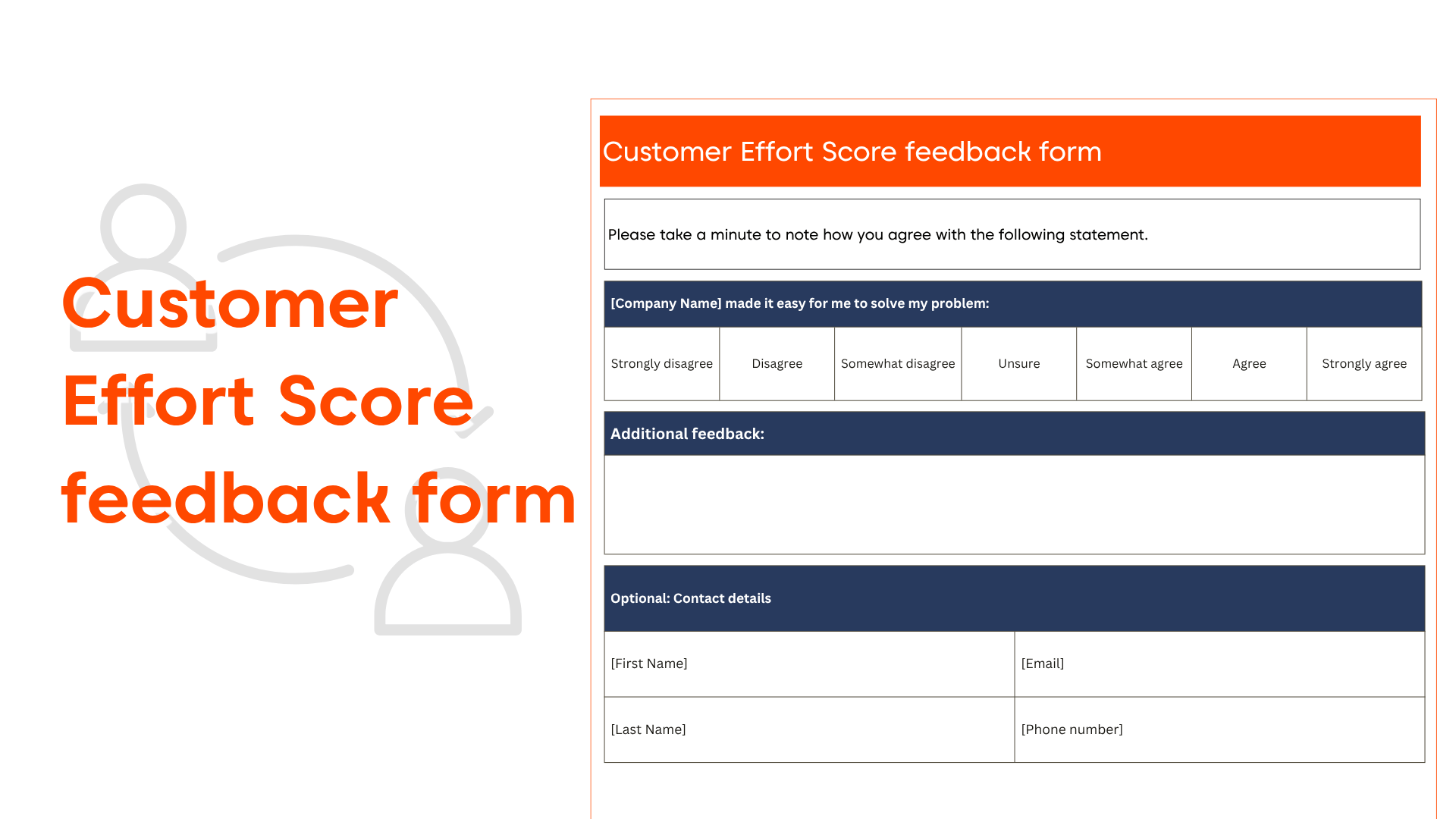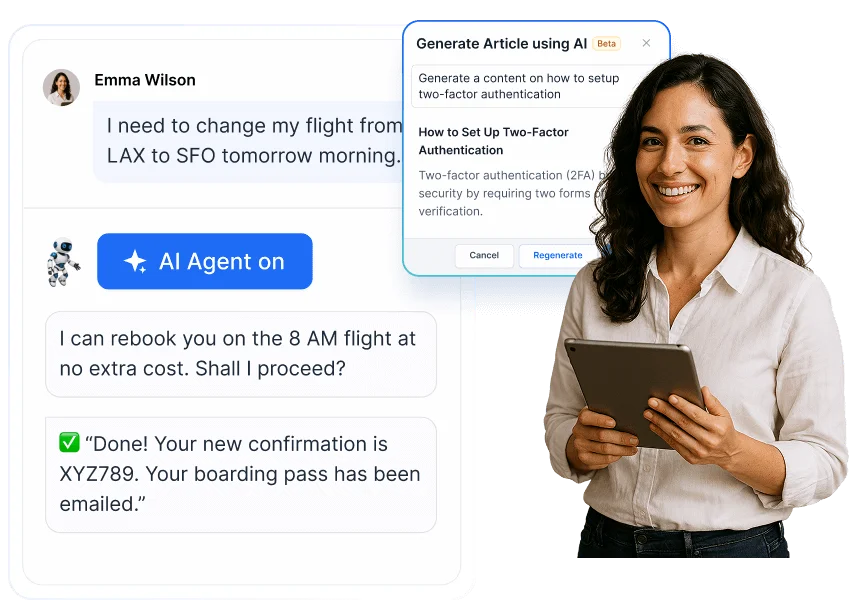Are you struggling to gather meaningful customer insights that actually improve your support quality? Feeling overwhelmed by low response rates and unclear feedback data?
Collecting customer feedback can be frustrating without the right feedback form template and strategy. If these customer feedback challenges sound familiar, then you’re in the right place.
This comprehensive guide features over 15 ready-to-use feedback form templates. Teams can quickly adopt these templates to collect meaningful input, assess satisfaction levels, and uncover areas for growth and improvement.
What is a customer feedback form?
A customer feedback form is a tool used by businesses to collect insights from customers about their experiences with products, services, or overall interactions. It helps assess satisfaction levels and highlights areas for improvement.
The core objective is to gather honest feedback that reveals customer perceptions, identifies strengths and weaknesses, and supports informed decisions to improve customer satisfaction and loyalty.
SurveySparrow reports that for every 1% increase in customer satisfaction, customer retention can grow by up to 5%. By acting on insights from customer feedback, businesses can boost satisfaction and drive long-term loyalty.
What should a feedback form include?
A thoughtfully crafted feedback form template is more than just a simple questionnaire—it’s a powerful tool for collecting insights.

These insights help drive meaningful improvements in your products, services, and overall user experience.
- Contact information – Optionally request contact details for follow-up, while clearly stating how the information will be used. This helps gather more context when needed, while still allowing for anonymous feedback.
- Open comment boxes – Include at least one open-ended question to let customers share their thoughts freely. These comments often reveal deeper insights or issues that structured questions might miss.
- Rating fields – Use standardized rating scales (like 1–5 or 1–10) to quantify satisfaction levels. This allows for measurable data collection, trend analysis, and performance comparisons over time.
- Targeted and specific questions – Design purposeful questions aligned with your goals to gather actionable insights. These should be carefully worded to reduce bias and encourage clear, meaningful responses.
- Overall satisfaction rating – Include a broad question to capture the customer’s general impression of the support experience, such as “How satisfied were you with your support today?” This serves as a benchmark to frame more detailed feedback and track overall service quality.
Best practices for creating effective feedback forms
According to a survey by Renascence, companies that regularly collect and act on customer feedback see a 15% boost in customer retention. That’s why it’s important to create effective feedback forms to gain valuable customer insights.
To ensure your feedback form yields high response rates and valuable insights, consider these best practices:
Keep it short and relevant
Ask only the questions that are truly necessary to meet your objective. Overly long or complex forms can lead to fatigue, causing customers to abandon the survey or provide rushed answers.
A concise, well-structured form encourages more thoughtful and genuine responses, resulting in higher-quality insights.
Leverage AI and automation
Use AI and automation in your support software to quickly understand customer feedback. These tools can spot sentiment trends, common issues, and patterns.
They also help send surveys on time and turn responses into clear, useful reports.
Use a variety of question types
In your feedback form template, combine a variety of satisfaction survey questions to gather both quantitative and qualitative insights.
- Rating scales (e.g., Likert, 1-5 stars): For measuring satisfaction or agreement.
- Multiple choice: For predefined options, making it easy for customers to respond.
- Open-ended questions: For capturing detailed, nuanced feedback and suggestions in the customer’s own words.
- Yes/No questions: For quick, binary answers.
Prioritize clear form design
Make your feedback form clear, branded, and easy for everyone to use. Use your brand’s colors, fonts, and logo for a consistent look.
Keep questions simple and design the form to be accessible for all users, including those with disabilities.
Pilot test your forms
Don’t send your feedback form to all customers before testing it. First, share it with a small group inside your team or a few customers.
Their feedback helps you fix confusing questions and technical problems, making the form better before a full launch.
Share across channels
Deliver feedback forms where your customers interact. Ensure feedback forms are available across your support touchpoints like email, chat, web, mobile, or self-service portals.
Close the feedback loop
Collecting feedback only helps if you use it to improve. Regularly review it to spot trends and take action, like improving processes or training staff.
Let customers know about the changes, it shows you value their input and encourages more feedback.
Ensure privacy
Let users submit feedback anonymously if they prefer. Always comply with privacy laws and be transparent about data usage.
Clearly state how the data will be used and assure customers of their privacy.
15 Customer feedback form templates for enhanced response
Whether you’re aiming to analyze customer satisfaction across multiple support channels or pinpoint areas for improvement in your service workflows. Our expertly crafted feedback forms enable you to capture actionable customer insights with precision.
Here are some versatile templates you can adapt and apply:
Customer satisfaction form (CSAT)
This feedback form template quickly measures customer satisfaction with a specific interaction or service, typically sent immediately after a support session.

To gather insights for customer satisfaction, consider asking questions like these:
Sample questions:
- Overall, how satisfied were you with the support you received today?
(Very Unsatisfied – Unsatisfied – Neutral – Satisfied – Very Satisfied ) - Was our team able to resolve your issue?
(Yes / No / Partially) - Do you have any additional comments about your experience?
(Open-ended text box)
Tip: Analyze key issues and trends from CSAT responses to determine what is effective and what requires enhancement. Respond to feedback and communicate the results to teams to enhance the customer experience and foster trust.
Customer effort score form (CES)
This customer feedback form evaluates the ease with which customers resolved an issue or completed a task. Lower effort scores often indicate higher loyalty.

To understand customer effort, here are some sample questions:
Sample questions:
- To what extent do you agree or disagree with the following statement: The company made it easy for me to handle my issue.
(Strongly Disagree – Disagree – Neutral – Agree – Strongly Agree) - How much effort did you personally have to put forth to handle your request?
(Very Low Effort – Low Effort – Neutral – High Effort – Very High Effort) - What made it easy or difficult to resolve your issue?
(Open-ended text box)
Tip: Find the areas where customers face the most challenges during interactions or processes. Simplify and streamline these points to minimize effort and improve the overall customer experience.
Net promoter score survey form (NPS)
This feedback form template measures long-term customer loyalty by asking how likely they are to recommend your company. It reflects brand health and advocacy.

To calculate your NPS and gather qualitative feedback, use questions such as:
Sample questions:
- On a scale of 0 to 10, how likely are you to recommend [Your Company/Product/Service] to a friend or colleague?
- What is the primary reason for your score?
(Open-ended text box) - What made it easy or difficult to resolve your issue?
(Open-ended text box)
Tip: Categorize respondents as Promoters, Passives, or Detractors to gain insights into their loyalty levels. Respond to the feedback by increasing engagement with promoters, converting passives, and addressing the concerns of detractors.
Post-support interaction feedback form
Use this feedback form template immediately after a support case is resolved to gather insights on agent helpfulness, resolution clarity, and overall experience.

To assess the effectiveness of a recent support interaction, consider these questions:
Sample questions:
- How satisfied were you with the agent who handled your request?
(Very Unsatisfied – Unsatisfied – Neutral – Satisfied – Very Satisfied) - How clear was the information or solution provided?
(Not at all Clear – Slightly Clear – Moderately Clear – Clear – Very Clear) - Was your issue resolved to your satisfaction during this interaction?
(Yes / No)
Tip: Analyze agent performance and customer satisfaction to pinpoint strengths and areas needing improvement. Leverage this information to train support teams, refine processes, and elevate future customer interactions.
Chat support feedback form
This feedback form template evaluates the effectiveness of live chat support and is typically embedded at the end of a session. It aids in refining both chatbot scripts and live agent performance.

To get feedback on your chat support, you might ask:
Sample questions:
- Please rate your satisfaction with this chat session.
(Very Poor – Poor – Average – Good – Excellent) - Was the chat agent knowledgeable and professional?
(Yes / No) - How would you rate he speed of the responses you received?
(Too Slow – Just Right – Very Fast)
Tip: Inspect feedback to enhance chat quality, response times, and resolution effectiveness. Apply these insights to train agents, improve scripts, and elevate the overall chat experience.
Email support feedback form
This customer feedback form template evaluates asynchronous email support, focusing on response time, resolution clarity, and professionalism, often sent in a follow-up email.

To evaluate your email support, consider the following questions:
Sample questions:
-
- How satisfied were you with the resolution provided via email?
(Very Unsatisfied – Unsatisfied – Neutral – Satisfied – Very Satisfied) - How would you rate the timeliness of our email response?
(Too Slow – Acceptable – Very Fast) - Do you have any suggestions for improving our email support?
(Open-ended text box)
- How satisfied were you with the resolution provided via email?
Tip: Evaluate feedback for clarity, tone, and how effectively issues were addressed. Utilize this insight to refine email templates, customize responses, and enhance agent training.
Phone support call feedback form
This feedback form template collects feedback on voice support regarding call clarity, agent politeness, problem resolution, and wait times, often via SMS or email follow-up.

To gather insights on your phone support, try these sample questions:.
Sample questions:
-
- How satisfied were you with your recent phone support experience?
(Very Unsatisfied – Unsatisfied – Neutral – Satisfied – Very Satisfied) - Was the support agent courteous and professional?
(Yes / No) - How would you rate the time you waited to speak with an agent?
(Too Long – Acceptable – Very Short)
- How satisfied were you with your recent phone support experience?
Tip: Evaluate feedback on call clarity, agent performance, and problem resolution. Use this information to refine call handling, train agents, and enhance the overall phone support experience.
Product or feature feedback form
Gathers user feedback on a specific product or feature, including usability, usefulness, bugs, and enhancement suggestions for product managers.

To collect direct feedback on your product or a specific feature, ask:
Sample questions:
- How satisfied are you with [Specific Product/Feature Name]?
(Very Unsatisfied – Unsatisfied – Neutral – Satisfied – Very Satisfied) - How easy is it to use [Specific Product/Feature Name]?
(Very Difficult- Difficult- Normal – Easy – Very Easy) - Did you encounter any issues or bugs while using [Specific Product/Feature Name]? If so, please describe them.
(Open-ended text box)
Tip: Determine what aspects of the product or feature users appreciate or struggle with. Use their feedback to enhance usability, introduce helpful features, or resolve any pain points.
Website usability feedback form
Collects feedback on website experience, including navigation, accessibility, load times, and content clarity to optimize digital customer touchpoints.

To understand how users experience your website, consider these questions:
Sample questions:
- Overall, how would you rate your experience navigating our website today?
(Very Poor – Poor – Average – Good – Excellent) - Were you able to easily find the information you were looking for?
(Yes / No) - Did you experience any technical issues (e.g., slow loading, broken links) while using our website? If so, please specify.
(Open-ended text box)
Tip: Leverage the feedback collected to enhance the site’s navigation, layout, and overall user experience. Identify areas that may be confusing, slow, or difficult to navigate, and make improvements accordingly.
Complaint resolution feedback form
Assesses if customers felt heard and their issue was satisfactorily resolved post-complaint, focusing on speed, empathy, and resolution quality.

After resolving a customer complaints, use these questions to gauge satisfaction with your feedback form template:
Sample questions:
- How satisfied are you with the way your recent complaint was handled?
(Very Unsatisfied – Unsatisfied – Neutral – Satisfied – Very Satisfied) - Do you feel that our team understood your concerns?
(Yes / No) - Was the resolution offered fair and satisfactory?
(Yes / No / Partially)
Tip: Use the feedback to refine resolution processes and provide training for teams to improve issue management. Evaluate whether customers believe their issues were addressed swiftly and fairly.
Onboarding experience feedback form
Captures feedback on the clarity, support quality, and overall satisfaction of the customer/employee onboarding journey to improve early retention.

To refine your customer onboarding process, consider asking new users:
Sample questions:
- Overall, how satisfied are you with your onboarding experience with [Your Company/Product Name]?
(Very Unsatisfied – Unsatisfied – Neutral – Satisfied – Very Satisfied) - How clear and helpful were the onboarding materials and instructions?
(Not at all Clear – Slightly Clear – Moderately Clear – Clear – Very Clear) - What part of the onboarding process did you find most helpful?
(Open-ended text box)
Tip: Incorporate feedback to refine guidance, simplify the steps, and enhance the overall experience. This also allows you to evaluate if new users felt welcomed, informed, and supported throughout the onboarding process.
Knowledge base article feedback form
A short form, often at the end of articles (e.g., “Was this article helpful?”), to improve content clarity and coverage in your help center.

To assess the usefulness of your knowledge base articles, include questions like:
Sample questions:
- Was this article helpful?
(Yes / No buttons) - How could we improve this article?
(Open-ended text box) - Did this article completely answer your question?
(Yes / No buttons)
Tip: Utilize the feedback to revise the content, enhance the structure, and include any omitted details. Determine whether readers considered the article to be helpful, clear, and easy to understand.
Client satisfaction survey form
Gathers feedback from B2B clients on service quality, communication, strategic alignment, and overall account management.

For feedback from your business clients, consider these types of questions:
Sample questions:
- Overall, how satisfied are you with the service provided by [Your Company Name] over the past [period, e.g., quarter, year]?
(Very Unsatisfied – Unsatisfied – Neutral – Satisfied – Very Satisfied) - How would you rate our team’s responsiveness to your needs and inquiries?
(Very Poor – Poor – Average – Good – Excellent) - How well do you feel our services align with your business goals?
(Not at all Well – Slightly Well – Moderately Well – Well – Very Well)
Tip: Utilize feedback to enhance relationships, improve services, and increase overall satisfaction. Assess what clients value most and identify areas for improvement.
General support service feedback form
A broad template covering all support aspects, useful for quarterly reviews to get a 360-degree view of your support system.

To get a comprehensive overview of your support services, ask questions like:
Sample questions:
- Overall, how satisfied are you with the support services provided by [Your Company Name]?
(Very Unsatisfied – Unsatisfied – Neutral – Satisfied – Very Satisfied) - How would you rate the helpfulness and knowledge of our support staff?
(Very Poor – Poor – Average – Good – Excellent) - How easy is it to get the support you need from us?
(Very Difficult- Difficult- Normal – Easy – Very Easy)
Tip: Use customer feedback to improve service quality, response times, and team performance. Make sure customers feel supported, understood, and that their issues are resolved.
In-app feedback form
Embedded directly in an application to capture real-time user feedback on app performance, bugs, or feature satisfaction with this feedback form template.

For instant feedback within your application, use questions such as:
Sample questions:
- How satisfied are you with your experience using [App Name/Specific Feature within App] right now?
(Scale: Emojis or 1-5 Stars) - Did you encounter any issues or frustrations while using [App Name/Specific Feature]?
(Yes / No) - Is there anything you particularly like or dislike about [App Name/Specific Feature]?
(Open-ended text box)
Tip: Actively monitor user feedback in real time to quickly resolve bugs, enhance features, and significantly improve the overall user experience of the app.
Perfect your support strategy with customer feedback forms
Thoughtfully designed customer feedback forms are essential to collecting meaningful insights and improving support outcomes.
With over 15 ready-to-use feedback form templates, your team can streamline feedback collection, spot service gaps, and drive continuous improvement. Consistent follow-up and clear communication help turn every response into an opportunity to grow.
BoldDesk simplifies this feedback loop even further. As a powerful helpdesk software, it enables you to automate survey delivery, analyze responses with AI, and close the loop effectively.
It’s the ideal solution for support teams aiming to boost efficiency, enhance customer satisfaction, and build lasting loyalty.
Do you have a specific feedback form template use case or industry in mind? Share your suggestions in the comments—we’d love to expand our customer feedback form template collection based on your needs.
Related articles
- How to Utilize Customer Feedback to Grow Your Business
- Customer Feedback Loop: Importance and How to Close It
Frequently asked questions
Customer feedback helps you:
- Fix problems quickly
- Measure satisfaction (like CSAT or NPS)
- Improve your service and train your team
- Build trust by showing you care
- Guide product updates with real customer input



















 Email Ticketing System
Email Ticketing System Shared Inbox Software
Shared Inbox Software Multi Brand Help Desk
Multi Brand Help Desk Internal Help Desk Software
Internal Help Desk Software Trouble Ticketing Software
Trouble Ticketing Software Mobile Help Desk
Mobile Help Desk 














